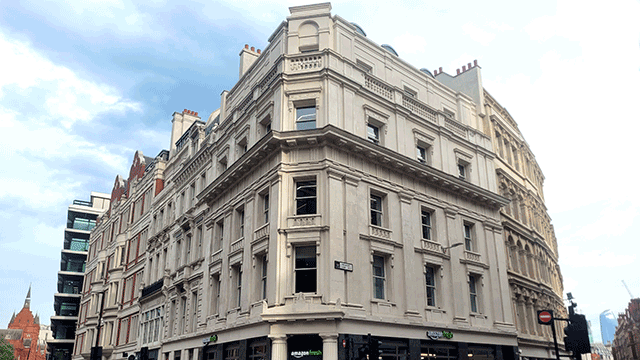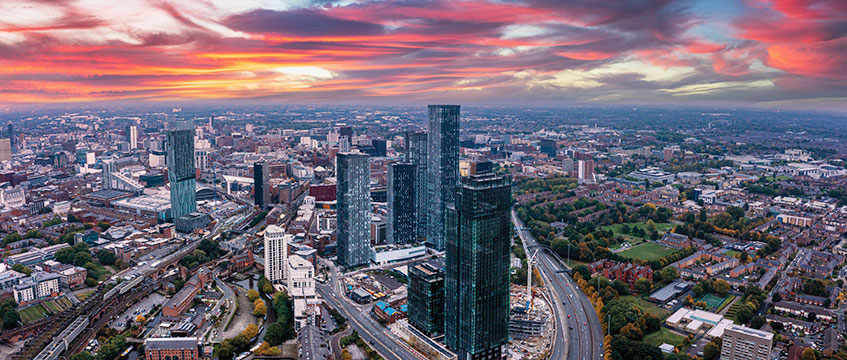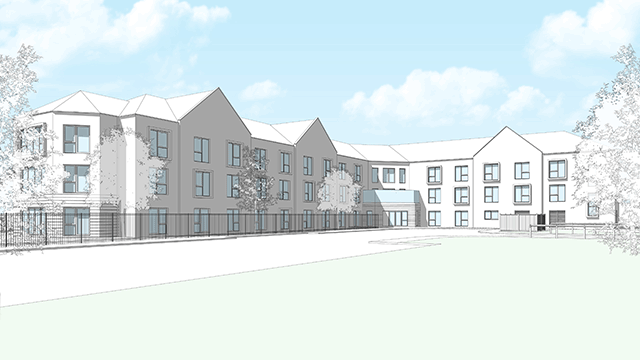As far as UK cities well-placed to support social impact development go, Manchester is up there. As far as UK cities demonstrating real examples of measurable social impact development go, Manchester – once again – is up there. And that’s what it is all about. Action. Not just any old action. Strategic action. Considered, detailed, sympathetic action. Action that not only puts the needs of local communities at the heart of the development process but does so with a keen eye on commercial success. Because, when it comes to making meanwhile meaningful, there can, and arguably should, be more than one winner.
From renowned Manchester-based social impact developer Capital & Centric’s £500m portfolio to LandsecU+I’s £1.4bn, 6.5-acre Mayfield Park scheme and Far East Consortium’s Victoria North in the Northern Quarter – both partnered with Manchester City Council, Manchester has long been a city where community engagement has not just informed, but fuelled, good development.
“Manchester is definitely a place where people learn to leave the ladder down for the next people to climb up,” says Capital & Centric founder Tim Heatley. “Looking out for each other is in our psyche.”
What about city governance? That too. “I think we are doing our best work in Manchester because the city demands it, enables it and encourages it,” says LandsecU+I’s creative director Martyn Evans. “We are in partnership with the city of Manchester, so we have a partner who understands, better than anyone else, the people of Manchester, the problems of Manchester and the opportunities of Manchester. This is a pioneering, ambitious, innovative city and that makes it very attractive place to develop.” He adds that, thanks to the benefit of clear local government policy and guidance, putting the needs of the people and communities at the heart of that development is considerably easier.

Nicola Rigby, a principal in Avison Young’s Manchester office agrees. “One thing the city of Manchester has done which has been incredibly valuable was come up with a very clear social impact strategy. From a development and investment perspective that means that anyone working on a project – particularly in a specific geography like the northern quadrant – has a very clear strategy on what they want us to leverage. That is invaluable in the context of what we do across real estate. It’s much harder to leverage genuine impact for local communities when we’re making that contribution up ourselves. It creates duplication, it creates overlap or it misses the point. So Manchester has done a really good job in having that absolute clarity on what it wants development and regeneration to really target from a social impact perspective.”
So the city persona lends itself to innovative social impact. As does the local government set-up. But how are these location-specific area traits translating into strategies and places that deliver real social impact rather than relying on “virtue signalling”? And why is it so important for the developers and investors themselves to benefit from the meaningful element of meanwhile, not just in Manchester but nationwide?
Generating genuine impact
“You won’t fix long-term problems with short-terms plans,” says Capital & Centric’s Heatley. “There is a lot of virtue signalling out there. It isn’t about turning up at the local community group to paint the walls white, going to a homeless shelter to serve meals or writing a cheque to the local football club and calling it social impact. That’s not getting right in there amongst it all.” So, what is?
Avison Young’s Rigby points to north Manchester as an area where regeneration programmes and social value have been a particular focus.
“Across north Manchester there are lots of big region programmes and initiatives [in areas such as] North Manchester Hospital and Victoria North. The city is now also looking at Strangeways. So that northern quadrant of the city has been a focus. Taking Victoria North as an example, this is somewhere we are seeing real, genuine, positive impact. The Far East Consortium has shaped its activities, it has a good social value lead based in Manchester and it is very much on the ground working with local community.”
Manchester is definitely a place where people learn to leave the ladder down for the next people to climb up. Looking out for each other is in our psyche.
Tim Heatley, Capital & Centric
She adds that heavy investment in affordable housing and school provision has resulted in the scheme being a “standout” from a social value perspective.
As for making meanwhile meaningful, for Rigby, one of those words takes on an entirely different meaning without the other. “Just that word ‘meanwhile’ is probably going to annoy people,” she says. “There is definitely a push-back as meanwhile suggests that whatever has been put in place is temporary. People will be like, ‘we don’t want a trendy café for six months. We want a town centre that’s thriving again.’”
She adds that this is particularly the case away from the more transient population of Manchester’s city centre, which is heavily populated by students. “Places like north Manchester are where meanwhile is going to be particularly controversial. This is where you have established local communities that don’t want gimmicks. They want long-term regeneration and investment. This is where coming in with something for a few months won’t work very well and where you need that meaningful meanwhile strategy even more. The point of the process should be to activate a space, bring people to that space and see the space as a test bed to make something permanent based on the needs of the local community.”

Another way to ensure that meanwhile becomes meaningful is to bring an expert on board, a strategy employed by LandsecU+I on its Mayfield project. Kelly Watson, director of urban solutions at engineering and business knowledge firm Hatch, has been working on the scheme advising on social impact strategy for the past three months. “We’ve been developing a social sustainability and quality of life strategy for Mayfield at masterplan level,” she says. “Prior to that we had been working closely with the project’s sustainability consultants and, as part of that process, I identified a need to strengthen the socio-economic component of the scheme. That was when we came on board officially and the two separate strategies – sustainability and social impact – have become one overarching sustainability strategy.”
This sort of long-term, detailed strategy is becoming more commonplace, she adds.
“We’ve seen this explosion in the past couple of years of clients wanting to respond to the social impact agenda, particularly in the private sector. I’m seeing a move away from developers just looking at the construction phase of projects towards a more holistic, placemaking agenda. It is definitely a more robust way of thinking about things.
“The best examples of social impact are where people say ‘let’s actually understand the needs of this site and then develop an evidence-based approach. On projects I would consider to be adopting best practice it’s no longer ‘oh, let’s do this meanwhile activity because so and so is involved in the project and they’re interested in this or that element that could offer temporary meanwhile use. If you get it right and your meanwhile or social impact is meaningful, then it is beneficial from that impact point of view but also helps to build the brand and raises awareness around the site so there are definitely commercial benefits too.”
Making places better
Indeed, meaningful social impact doesn’t have to be beneficial for the local community in isolation. In fact, it really shouldn’t be. Not least because well thought-through, properly executed social impact development has exponentially more chance of becoming the increasingly widespread norm if the commercial benefits can also be clearly demonstrated.
This is something a number of developers operating in Manchester are not afraid to discuss openly and candidly. “Doing something good to helps others also helps us,” says Capital & Centric’s Heatley. “I have never been shy of saying that. If you talk about being on a social mission it can be met with cynicism. But I am not some goodie two shoes. What we do is good for us as well. When you are looking to get on, helping others to get on too means no one is going to stand in your way. Property developers are not always seen as the most supportive, inclusive people and helping others will create the most frictionless route to cracking on. That doesn’t mean we don’t care. Social impact must be done from the heart to work but that means everyone has to believe in the project. That’s why what we do has to be good for business. You have got to be honest about that as a developer.”
Evans agrees, “Everything we do is affected by buildings and the spaces in between them. We, as developers, should be coming to work every day recognising that responsibility and understanding that, if we do it right, we can sleep at night and make more money. I don’t understand why anyone thinks that it’s not the way we should be doing things. Why is it bad to want to develop something that will make more money? All of this is about making places better. And the places that are better are more valuable.”
And it is cyclical, adds Heatley. A continuous knock-on effect from community to developer and back again. “Take Manchester,” he says. “The better the city is, the busier it will be. The busier it is the more customers we then have to live in our homes and work in our offices. Whichever way you look at it, supporting the local community is good for us. It just makes sense.”

Manchester’s social impact policy
Key priority actions
- Maximise new job creation
- Support unemployed residents to re-enter work
- Support organisations that make a positive contribution and retain money in the local economy
- Support transition to a zero-carbon city.
- Ensure ‘good employment’ is centre to any opportunities
- Focus charitable giving on We Love MCR Charity, Young Manchester and Big Change
- Facilitate donations of surplus food
- Make use of the social value fund
Evaluation
- Invitation to tenders have dedicated questions on the social value outcomes. Normally 20% of the score applied in tenders will be allocated to social value
- All procurements will allocate an additional 10% of the evaluation score to a supplier’s contribution to carbon reduction within their own operations
- Social value commitments (including key performance indicators) are recorded in contract award reports
- Contract managers monitor delivery of social value as a core part of their contract monitoring
To send feedback, e-mail emily.wright@eg.co.uk or tweet @EmilyW_9 or @EGPropertyNews











